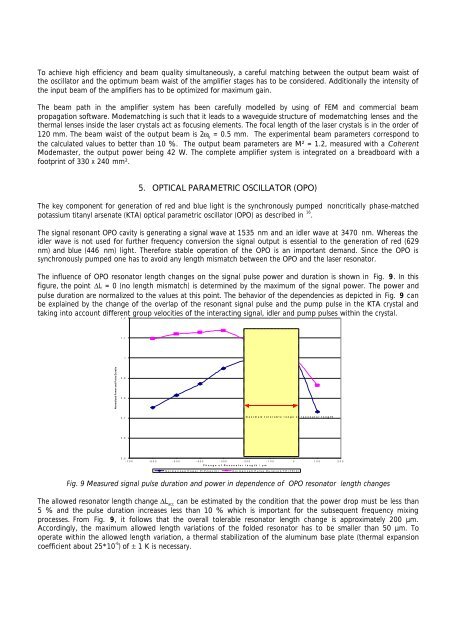RGB lasers for laser projection displays - Crystech
RGB lasers for laser projection displays - Crystech
RGB lasers for laser projection displays - Crystech
You also want an ePaper? Increase the reach of your titles
YUMPU automatically turns print PDFs into web optimized ePapers that Google loves.
To achieve high efficiency and beam quality simultaneously, a careful matching between the output beam waist of<br />
the oscillator and the optimum beam waist of the amplifier stages has to be considered. Additionally the intensity of<br />
the input beam of the amplifiers has to be optimized <strong>for</strong> maximum gain.<br />
The beam path in the amplifier system has been carefully modelled by using of FEM and commercial beam<br />
propagation software. Modematching is such that it leads to a waveguide structure of modematching lenses and the<br />
thermal lenses inside the <strong>laser</strong> crystals act as focusing elements. The focal length of the <strong>laser</strong> crystals is in the order of<br />
120 mm. The beam waist of the output beam is 2ω o = 0.5 mm. The experimental beam parameters correspond to<br />
the calculated values to better than 10 %. The output beam parameters are M² = 1.2, measured with a Coherent<br />
Modemaster, the output power being 42 W. The complete amplifier system is integrated on a breadboard with a<br />
footprint of 330 x 240 mm².<br />
5. OPTICAL PARAMETRIC OSCILLATOR (OPO)<br />
The key component <strong>for</strong> generation of red and blue light is the synchronously pumped noncritically phase-matched<br />
potassium titanyl arsenate (KTA) optical parametric oscillator (OPO) as described in 16 .<br />
The signal resonant OPO cavity is generating a signal wave at 1535 nm and an idler wave at 3470 nm. Whereas the<br />
idler wave is not used <strong>for</strong> further frequency conversion the signal output is essential to the generation of red (629<br />
nm) and blue (446 nm) light. There<strong>for</strong>e stable operation of the OPO is an important demand. Since the OPO is<br />
synchronously pumped one has to avoid any length mismatch between the OPO and the <strong>laser</strong> resonator.<br />
The influence of OPO resonator length changes on the signal pulse power and duration is shown in Fig. 9. In this<br />
figure, the point ΔL = 0 (no length mismatch) is determined by the maximum of the signal power. The power and<br />
pulse duration are normalized to the values at this point. The behavior of the dependencies as depicted in Fig. 9 can<br />
be explained by the change of the overlap of the resonant signal pulse and the pump pulse in the KTA crystal and<br />
taking into account different group velocities of the interacting signal, idler and pump pulses within the crystal.<br />
Normalized Power and Pulse Duration<br />
1,2<br />
1,1<br />
1<br />
0,9<br />
0,8<br />
0,7<br />
0,6<br />
0,5<br />
-700 -600 -500 -400 -300 -200 -100 0 100 200<br />
Change of Resonator length / µm<br />
maximum tolerable range of resonator length<br />
Normalized Power P/Pmax(0) Normalized Pulse Duration TP/TP(0)<br />
Fig. 9 Measured signal pulse duration and power in dependence of OPO resonator length changes<br />
The allowed resonator length change ΔL acc can be estimated by the condition that the power drop must be less than<br />
5 % and the pulse duration increases less than 10 % which is important <strong>for</strong> the subsequent frequency mixing<br />
processes. From Fig. 9, it follows that the overall tolerable resonator length change is approximately 200 µm.<br />
Accordingly, the maximum allowed length variations of the folded resonator has to be smaller than 50 µm. To<br />
operate within the allowed length variation, a thermal stabilization of the aluminum base plate (thermal expansion<br />
coefficient about 25*10 -6 ) of ± 1 K is necessary.


